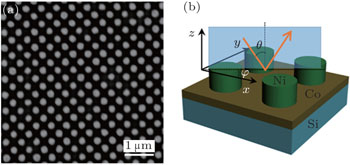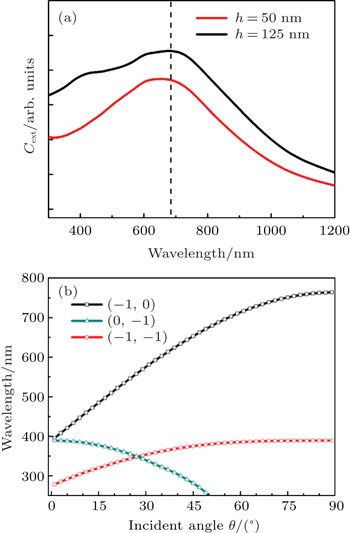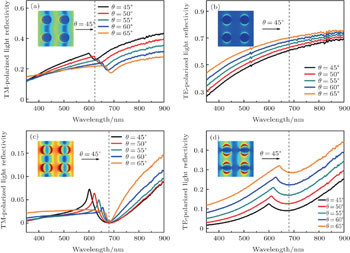† Corresponding author. E-mail:
Project supported by the National Key Project of Fundamental Research of China (Grant No. 2012CB932304) and the National Natural Science Foundation of China (Grant Nos. 11374146 and U1232210).
We report a pure ferromagnetic metallic magnetoplasmonic structure consisting of two-dimensional ordered Ni nanodisks array on Co film. With a sufficient height of the nanodisks, a steep and asymmetric Fano resonance can be excited in this structure. We attribute the fascinating spectral lineshape to the strong coupling between the excitation of surface plasmon polaritons at the interface and the localized surface plasmon resonance of nanodisks. The conclusion is fully confirmed by spectrum measurements in nanostructures with different heights. Furthermore, the enhancement and sign of the magneto-optical Kerr rotation in this structure are significantly modified by the Fano resonance.
Benefited from the development of plasmonics, we can concentrate the light in sub-wavelength scale to break the diffraction limit and manipulate it more delicately and efficiently via the excitation of the surface plasmons (SPs).[1–3] Such fascinating modification of the electromagnetic field leads to lots of nonlinear optical effects,[4,5] and it even results in magneto-optical (MO) effects in non-magnetic nanocomposites.[6] Therein, the magnetoplasmonics combining magneto-optics and plasmonics has attracted extra attention due to the multifunctionality that can enhance the MO effects and control SPs actively.[7–9] This leads to a variety of applications, such as ultra-sensitive detector,[10,11] optical isolators,[12,13] ultra-precise MO ruler,[14] etc. The demonstration of the SPs and the consequent enhancement of the MO effects have been well discussed in magnetoplasmonic nanostructures.[15–18] However, there is a non-negligible problem in most of nanocomposites. The incorporation of non-FM materials would dilute the volume fraction of ferromagnetic (FM) materials, which accordingly weakens the overall MO effect, though the effect has been enhanced due to the excitation of SPs.[19]
A direct pathway to overcome this problem is to fabricate magnetoplasmonic structures using pure ferromagnetic (FM) metals. However, due to the Ohmic losses, the typical FM metals cannot provide a sharp SP resonance which usually brings a significant enhancement of the MO effect.[9,20] The Fano resonance possessing a steep, asymmetric line shape is considered as a proper alternative to be implanted into the pure FM magnetoplasmonic structures.
The underlying mechanism of Fano resonance is accepted as the coupling between a narrow discrete resonance and an overlapping broad one.[21] It can be caused by the interference between surface plasmon polariton (SPP) modes,[22] between localized surface plasmon (LSP) modes of different parts,[23] or between the LSP mode and the Rayleigh anomalies.[24] In this work, we introduce a new type of Fano resonance, resulting from the coupling between overlapped LSP and SPP modes in the pure FM magnetoplasmonics structure, by constructing two-dimensional (2D) ordered Ni nanodisks on Co film. Two samples with different heights of the Ni nanodisks are prepared to reveal the origin of the Fano resonance and the influence to the MO Kerr rotation.
Our samples were fabricated mainly by magnetron sputtering, interference lithography (IL), and electrochemical deposition. A layer of Co film was deposited on a clean 2 × 2 cm2 silicon wafer with the thickness of 50 nm by magnetron sputtering. A 150-nm-thick photoresist (Allresist, ARP-3170) was spin-coated on the prepared Co substrate. After a pre-bake at 95 °C for 1 min, the photoresist was exposed by a home-made Lloyd’s mirror system. The diameter of the laser beam of a 442-nm-wavelength He–Cd laser was pre-expanded to 8.0 cm to construct large-area highly ordered nanostructures. The substrate was exposed twice separately along the two orthogonal directions. After immersed in a developing solution for 45 s (Allresist, AR 26), a square lattice pattern of holes was produced. O2 plasma etching was used to remove the residual resist inside the holes to facilitate the following electrochemical deposition. Ni was electrodeposited into the ordered array of holes from a solution containing 15 g/L NiSO4·6H2O and 30 g/L H3BO3 with the current density of 0.1 mA/cm2. After the final remove process of dipping samples into acetone in a 60 °C water bath for 10 min, the ordered Ni nanodisks were constructed on the Co film. According to the principle of interference lithography, the period of the pattern can be given by λ/(2sin θ), where λ is the laser wavelength and θ is the incident angle of the laser beam. The height of the Ni nanodisks depends on the time of the electrochemical deposition. Here, we fabricated samples with two different kinds of heights, named A for the 50-nm-high one and B for the 125-nm-high one.
Figure
Unlike the noble metals, Ni provides a relatively flat LSP resonance due to the intrinsic large damping.[9] The extinction cross sections of the 200-nm-radial Ni nanodisks with 50 nm height and 125 nm height were calculated by the FDTD method, as shown in Fig.
Besides the LSP resonance from the single Ni nanodisk, the ordered array can excite SPP modes at the interface by grating coupling. The momentum match condition can be used to obtain the relation between the wavelength of the incident light and the incident angle for the given diffraction orders and the certain period, which can be expressed as[26]


According to the momentum match condition, the incident wavelengths to excite SPP modes for several diffraction orders were calculated, as shown in Fig.
The excited SP modes in magnetoplasmonic structures are related to the polarization state of the incident light. For the TE-polarized incident light, whose E field is perpendicular to the incident plane, the electrons in Ni nanodisks are driven along the y axis by the E field with a phase lag ascribed to damping when φ = 0°, according to the coordinate system in Fig.
According to the results of the simulations, the LSP mode of the Ni nanodisks and the (−1, 0) order SPP mode in our samples are excited simultaneously when the TM-polarized light impinges on the interface with the incident angle near 45°. However, for TM-polarized incident light on Sample A, as shown in Fig.
For Sample B, the Fano-like lineshape appears in Fig.
The differences of the reflectivity spectra clearly reveal the difference of inner SP modes between the two samples, which can also be reflected on the longitudinal MO Kerr rotation spectrum in Fig.
 | Fig. 4. Measured longitudinal MO Kerr rotation for TM-polarized light at φ = 0° and θ = 45°. The inset is the measured results of Sample A in the spectral range from 615 nm to 700 nm. |
The 30-nm-high nanodisk placed on the glass substrate has been reported to excite the LSP resonance on it.[25] However, we cannot find the LSP mode which should appear in Sample A. The LSP mode in nanodisks is considered as the result of the radial spatial confinement.[25] In the Co/Ni complex system where the Ni disks are constructed on the Co film, the collective oscillation of the free electrons on the nanodisks induced by the incident light will rapidly transfer to the conductive Co film, losing the spatial confinement, if the height of the disk is not sufficient, which hinders the excitation of effective LSPs and consequently prevents the Fano resonance.
In our previous work on Co antidots film and Co double layer film, the interaction between different orders’ SPPs leads to variety of line shapes of the Kerr spectrum and the enhancement of the MO signal.[26,27] Especially, in Co double layer film, it has been proposed as a possible explanation that an unusual sign change of the Kerr angles is due to the interaction between SPPs from bottom layer and LSPs from top layer.[26] In Sample B, the sign change is observed again. By the comparison between Sample A and B, it is clear that it is the Fano resonance which results in the sign change and the existence of the LSP mode, and Fano resonance is closely linked with the heights of the Ni disks.
In conclusion, we have fabricated the Co/Ni complex nanostructure, with 2D ordered Ni nanodisks on Co film, by the interference lithography and electrochemical deposition. The longitudinal MO Kerr spectrum is significantly modified by the Fano resonance, not only the enhancement but also the reversal of the rotation. Thus, it can be a promising way to produce coupled plasmonic devices in macroscopic scale, acting as a new type of MO-based ultrahigh sensitive biochemical sensors.[10,11] By comparison between the two samples with different heights of the ordered Ni nanodisks, it can be seen that the strong coupling between the LSP mode and the SPP mode is the fundamental source of the Fano resonance in our Co/Ni complex nanostructure. Either the lack of any SP mode or the imbalance of their intensity will destroy the Fano-like spectral lineshape.
| 1 | |
| 2 | |
| 3 | |
| 4 | |
| 5 | |
| 6 | |
| 7 | |
| 8 | |
| 9 | |
| 10 | |
| 11 | |
| 12 | |
| 13 | |
| 14 | |
| 15 | |
| 16 | |
| 17 | |
| 18 | |
| 19 | |
| 20 | |
| 21 | |
| 22 | |
| 23 | |
| 24 | |
| 25 | |
| 26 | |
| 27 |





